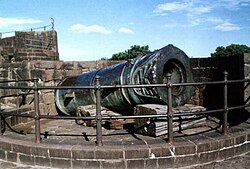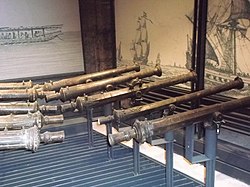Cannon
A cannon is a type of artillery, or large gun. They are made with a large tube called "barrel", and shoot projectiles. Cannons were first made in China, and were used with another Chinese invention, gunpowder. The gunpowder was put at the back of the tube, and the projectile, usually a cannonball, was placed in front. The gunpowder was set on fire, and would explode. This pushed the cannonball out the front of the tube towards the enemy. Howitzers and mortars are similar to cannons but they have shorter barrels and shoot the projectiles (that is: balls or shells) higher.
A field gun is a cannon if its barrel length is more than 35 times its caliber (the inner diameter, "bore", of its shell pathway). If the barrel length is 10 to 35 times the caliber, it is a howitzer. Less than 10 times are called mortars.
Modern guns that can shoot many big projectiles quickly and automatically are called autocannons. Modern cannons are usually used on warships and tanks.
| Wikimedia Commons has media related to Lua error in Module:Commons_link at line 62: attempt to index field 'wikibase' (a nil value).. |
Cannon Media
Bronze cannon with inscription dated the 3rd year of the Zhiyuan era (1332) of the Yuan dynasty (1271–1368); it was discovered at the Yunju Temple of Fangshan District, Beijing in 1935.
A bronze "thousand ball thunder cannon" from the Huolongjing.
Earliest picture of a European cannon, "De Nobilitatibus Sapientii Et Prudentiis Regum", Walter de Milemete, 1326
Cannon from the 15th century at Šibenik city walls
The Dardanelles Gun, a 1464 Ottoman bombard
Malik E Maidan, a 16th-century cannon, was effectively used by the Deccan sultanates, and was the largest cannon operated during the Battle of Talikota.
Experimental bronze multi barrel cannon created by the Ottoman Empire in the 16th century, located at Les Invalides
Firing of a field gun of the early 17th century with a linstock









